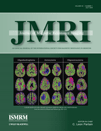Direct MR arthrography of the shoulder at 3 tesla: Optimization of gadolinium concentration
Abstract
Purpose
To determine the optimal concentration of gadopentetate dimeglumine for direct shoulder MR arthrography at 3T in vivo.
Materials and Methods
Sixty-eight consecutive shoulder MR arthrograms were obtained with 1 mmolGd/L (n = 12), 2 mmolGd/L (n = 12), 4 mmolGd/L (n = 12), 6 mmolGd/L (n = 12), 9 mmolGd/L (n = 10) and 12 mmolGd/L (n = 10). All postinjection fat-suppressed T1-weighted and T2-weighted images were analyzed retrospectively. For qualitative evaluation, image contrast was graded on a subjective three-level scale (excellent, moderate, and poor). For quantitative analysis, the contrast-to-noise ratio (CNR) of intra-articular fluid to muscle was measured.
Results
All postinjection T1-weighted images and T2-weighted images with 1 mmolGd/L, 2 mmolGd/L, 4 mmolGd/L, and 6 mmolGd/L were qualitatively evaluated as excellent or moderate. Two of the ten 9-mmolGd/L images and seven of the ten 12-mmolGd/L images were rated as poor with regard to the T2 image contrast. On the T1-weighted images, no significant difference existed between the CNRs of the six concentrations, but a peak CNR was seen at the concentration of 6 mmolGd/L. On the T2-weighted images, CNRs at concentrations of 1 mmolGd/L, 2 mmolGd/L, 4 mmolGd/L, 6 mmolGd/L, and 9 mmolGd/L showed no statistical difference, but were all significantly higher than that with 12 mmolGd/L.
Conclusion
The acceptable concentration of gadopentetate dimeglumine for shoulder MR arthrography at 3T was found to be in the range of 1 mmolGd/L to 6 mmolGd/L. 6 mmolGd/L may be the optimal concentration. J. Magn. Reson. Imaging 2009;30:229–235. © 2009 Wiley-Liss, Inc.




